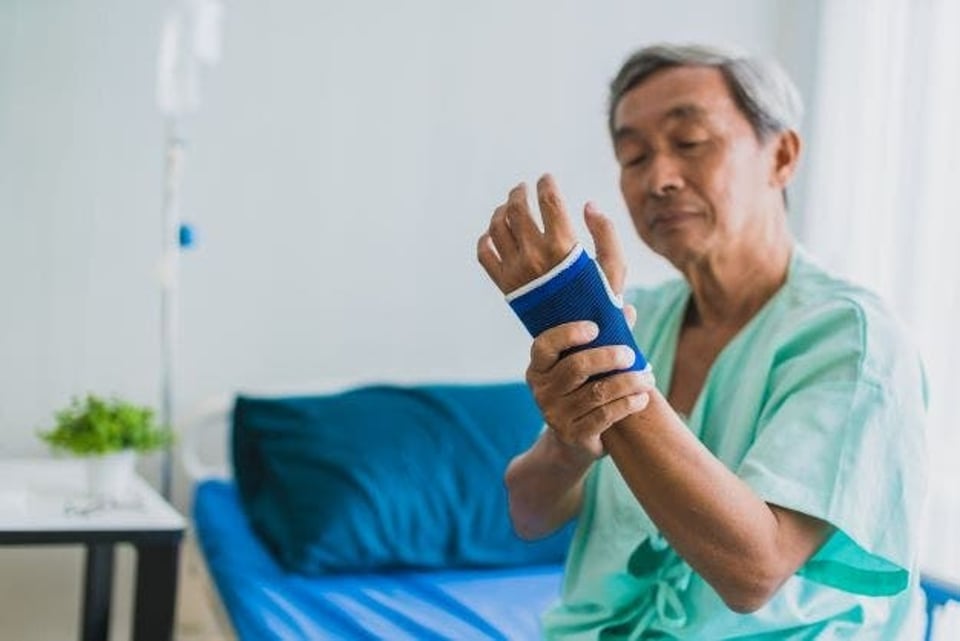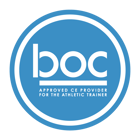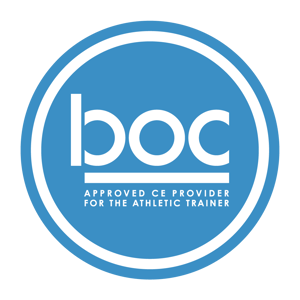Hand and Wrist Fractures and Dislocations

Description
This course will guide rehab professionals to a thorough understanding of how to evaluate and treat adult patients who have been diagnosed with fractures or dislocations of bones in the wrist (carpus) or hand. (This course does not cover distal radius fractures.) The course discusses relevant anatomy and physiology, the effects of hand/carpal injuries on function, fracture types, and some of the most commonly occurring complications and co-morbidities. The course examines conservative treatment options, surgical intervention, the types of surgery most often performed, rehabilitation after injury, and long-term prognosis. It presents evaluation tips and specific intervention techniques and exercises for best results in order to maximize the patient’s functional outcomes. This course will be immediately useful in clinical practice for all clinicians who deal with these injuries.



Physicourses is an AOTA Approved Provider of professional development. Course approval ID# 6295. This distance learning-independent course is offered at 0.8 CEUs Intermediate Level, OT Service Delivery, Foundational Knowledge. AOTA does not endorse specific course content, products, or clinical procedures.
Available Course Credits
| Alaska State PT & OT Board | 8.00 | ||
 |
AOTA | 8.00 | |
| Arizona State Board of Physical Therapy | 8.00 | ||
| Arkansas State Board of Physcial Thearpy | 8.00 | ||
 |
BOC | 8.00 | |
| California Physical Therapy Board | 8.00 | ||
| Colorado Division of Professions and Occupations | 8.00 | ||
| Connecticut Department of Public Health | 8.00 | ||
| Delaware Examining Board of Physical Therapists and Athletic Trainers | 8.00 | ||
| District Of Columbia Department of Health | 8.00 | ||
| FPTA | 8.00 | ||
| Georgia State Board of Physical Therapy | 8.00 | ||
| Hawaii Board of Physical Therapy | 8.00 | ||
| Idaho Physical Therapy Licensure Board | 8.00 | ||
| Indiana Physical Therapy Board | 8.00 | ||
| Iowa Board of Physical Therapy and Occupational Therapy | 8.00 | ||
| Kansas State Board of Healing Arts | 8.00 | ||
| Kentucky Board of Physical Therapy | 8.00 | ||
| Louisiana Physical Therapy Board | 8.00 | ||
| Maine Board of Physical Therapy | 8.00 | ||
| Maryland Board of Physical Therapy Examiners | 0.80 | ||
| Massachusetts Board of Allied Health Professionals | 8.00 | ||
| Michigan Board of Physical Therapy | 8.00 | ||
| Mississippi State Board of Physical Therapy | 16.00 | ||
| Montana Board of Physical Therapy Examiners | 8.00 | ||
| Nebraska Department of Health and Human Services | 8.00 | ||
| New Mexico Physical Therapy Board | 8.00 | ||
| North Carolina Board of Physical Therapy Examiners | 8.00 | ||
| North Dakota Board of Physical Therapy | 8.00 | ||
| Office of Professional Regulation, Vermont Secretary of State | 8.00 | ||
| Oklahoma Board of Medical Licensure and Supervision - Physical Therapy | 8.00 | ||
| Oregon Board of Physical Therapy | 8.00 | ||
| Pennsylvania Bureau of Professional and Occupational Affairs - Physical Therapy | 8.00 | ||
| Physical Therapy Governing Board New Hampshire | 8.00 | ||
| South Carolina Board of Physical Therapy | 8.00 | ||
| South Dakota Physical Therapy License Board | 8.00 | ||
| State of Alabama Board of Physical Therapy | 8.00 | ||
| State of Rhode Island Department of Health | 8.00 | ||
| Tennessee Board of Physical Therapy | 8.00 | ||
| Utah Physical Therapy Licensing Board | 8.00 | ||
| Virginia Board of Physical Therapy | 8.00 | ||
| Washington State Board of Physical Therapy | 8.00 | ||
| West Virginia Board of Physical Therapy | 8.00 | ||
| Wisconsin Physical Therapy License Board | 8.00 | ||
| Wyoming Board of Physical Therapy | 8.00 |
Course Procedure
- Enroll in the course.
- View the course content.
- Take the test. (You must score 80% to pass. If you do not pass, you may retake the test.)
- Print your certificate of completion.
Course Content
| 422a Hand and Wrist Fractures and Dislocations | Module | ||
| Course Evaluation | Module |
Sarah R.Stillings, MA, PT, MPT, CHT
Sarah R. (Sally) Stillings is a PT and Certified Hand Therapist in Texas. She received her physical therapy degree from the University of North Carolina at Chapel Hill. Prior to becoming a therapist, Sally taught university-level writing courses and was assistant editor of The Journal of Craniomandibular Practice. In her extensive career as a PT, she has held a variety of clinical, teaching, administrative, and business roles, including general PT practitioner, upper extremity specialist, clinic manager, hand therapy clinic coordinator, continuing education (CE) instructor, and CE course administrator. She has also served as Executive Director of the Kellermann Foundation, a U.S. nonprofit organization supporting healthcare and community development in Uganda, East Africa. Her work now focuses on creating evidence-based CE materials for rehab professionals. Sally is a lifelong runner who celebrates all those who cover the ground.

422 Hand and Wrist Fractures and Dislocations—Course Objectives After successfully completing this continuing education course, the learner should be able to:
- Identify applied anatomy of the distal upper extremity: bones, joints, nerves, muscles, blood vessels, and lymphatic vessels
- Recall the physiology of healing stages after a fracture
- Differentiate how hand and wrist fractures and associated soft tissue injuries are classified
- Recognize major carpal and hand fracture and dislocation attributes, including common fracture patterns, presenting symptoms, typical diagnostic testing and medical intervention, normal healing time, and common co-morbidities
- Identify common complications associated with hand and wrist fractures 6. Identify the epidemiology of carpal and hand fractures in the U.S.
- Recall conservative therapeutic interventions for treating hand and wrist fractures and dislocations
- Recall types of surgical interventions for the most common carpal and hand fractures 9. Differentiate rehabilitation strategies for hand and wrist fractures and dislocations
- Apply comprehensive treatment approaches to help patients regain function using case studies
- Recognize when to refer patients for specialized care
422 Hand and Wrist Fractures and Dislocations—
Table of Contents Page #
HOUR 1
Course Instructions 2
About the Author / Course Description 3
Course Objectives 4
Table of Contents 5
Introduction 9
Chapter 1: Applied Anatomy and Physiology 10
Impact of Hand and Wrist Injuries
Gross Anatomy Review: Distal Forearm, Wrist, & Hand 11
Bony
Anatomy
Distal Forearm
Wrist
Hand
Joints of the Distal Upper Extremity 15
Distal Radioulnar Joint (DRUJ)
Radiocarpal Joint
Intercarpal Joints
Carpometacarpal (CMC) Joints
MP and IP Joints
Nerves of the Wrist and Hand 19
Radial Nerve
Median
Nerve Ulnar
Nerve
HOUR 2
Musculature of the Forearm & Hand 22
Forearm Muscles
Intrinsic Hand Muscles
Circulatory System of the Distal Upper Extremity 25
Arteries and Veins
Lymphatic Vessels
Review: Physiology of Bone Healing 29
Bone Structure
Stages of Fracture Repair
Inflammation
Repair
Remodeling
Chapter 2: Presentation, Diagnosis, and Complications 34
Fracture Types
Fracture Classifications 35
Carpal Fractures and Dislocations 37
Most Common Carpal Fractures
Scaphoid
HOUR 3
Case Study One 41
Triquetru
m
Trapezium
Lunate
Less Common Carpal Fractures 48
Capitate
Pisiform
Hamate
Trapezoid
Complications of Carpal Fractures and Dislocations 52
Fractures and Dislocations of the Hand 54
Thumb Basal Metacarpal Fractures
Bennett’s Fracture
Rolando’s Fracture
Other CMC Dislocations and Fracture-Dislocations
Metacarpal Shaft Fractures
HOUR 4
Metacarpal Neck Fractures 60
Boxer’s Fracture
Metacarpophalangeal (MP) Joint Dislocations
Proximal Phalanx (P1) Fractures
PIP Joint Dislocations and Fracture-Dislocations 66
Pure Dislocation
Volar Base Fracture-Dislocation
Dorsal Base Fracture-Dislocation
Pilon Fractures
Distal Phalanx (P3) Fractures
Tuft Fracture
Case Study Two 73
Dorsal Base Avulsion Frac./Mallet Finger
DIP and Thumb IP Dislocations
Complications of Hand Fractures and Dislocations 76
Chapter 3: Nonsurgical Fracture Fixation 78
Isolated Carpal Fractures
Scaphoid
Other Carpal Fractures
HOUR 5
Carpal Dislocations and Fracture-Dislocations 81
Scapholunate Dissociation
Hand Fractures 82
First Metacarpal
Metacarpals 2–5
Proximal and Middle Phalanges
Distal Phalanx
Hand/Finger Dislocations 85
Case Study Three 86
Chapter 4: Surgical Intervention 87
Guidelines for Surgical Intervention
Common Surgical Approaches 88
Closed Reduction with Internal Fixation (CRIF)
Steinmann Pins
Kirschner Wires
Screws
Open Reduction with Internal Fixation (ORIF)
Plate and Screws
Intramedullary Nailing
Case Study Four 94
External Fixation
Specific Fractures and Dislocations 95
Scaphoid
Other Carpal Fractures
Carpal Fracture-Dislocations
Metacarpal Fractures
Base Shaft
Neck/Head
HOUR 6 Phalangeal Fractures 101
Extra Articular
Next Steps in Healing 104
Chapter 5: Patient Evaluation 105
Evaluation Review
General Medical and Social History
History of the Current Complaint
Physical Examination 109
Visual Inspection
Range of Motion Measurements
Edema Measurements
Sensory Evaluation
Case Study Five 115
Strength
Assessment Self-Report
Instruments
HOUR 7
Chapter 6: Rehabilitation and Return to Function 119
Patient Education
Edema Reduction 121
Retrograde Edema Massage
Other Edema Reduction
Techniques Compression
Therapy Electrical
Stimulation Pulsed
Ultrasound Therapeutic
Stretch Tape
Early Controlled Motion 125
Tendon Gliding
Progression of Motion
Pain Management 129
Modalities
Complex Regional Pain Syndrome
Orthoses 131
Prefabricated Splints and Braces
Case Study Six 132
Custom Orthosis Fabrication
Wound Care and Scar Management 135
Regaining Range of Motion
Improving Dexterity
Increasing Strength
HOUR 8
Returning to Full Function 139
Conclusion 141
Appendix A: Patient Education Resources 142
Appendix B: Evaluation Resources 144
References 146
Examination 153
Evaluation 163
Customer Cancellation:
Customers may request cancellations of their enrollment or subscription in our digital or live educational services, subject to the terms outlined below. Cancellation requests must be made in writing, either through email or through our designated cancellation process.
Refund Policy:
Refunds will be provided according to the following guidelines: i) For cancellation requests made within 5 days of the initial enrollment or subscription, a full refund will be issued. Refunds will be issued using the same method of payment used for the original transaction, unless otherwise agreed upon in writing.
Physicourses Conflict of Interest Disclosure Policy for Authors and Staff:
All persons in a position to control the content of any educational activity (authors or staff from Physicourses) are required to disclose to Physicourses any potentially biasing or potential conflict of interests in relationships of a financial, professional, or personal nature.
The intent of this disclosure is not to prevent authors or staff with commercial affiliations from planning an educational activity, or to prevent a Presenter with commercial affiliations from presenting, but rather to inform Physicourses of any potentially biasing relationships so that conflicts are resolved prior to the activity.
It is the policy of Physicourses to ensure balance, independence, objectivity and scientific rigor in all of its continuing education activities. All relevant conflicts of interest identified by the planner, presenter, or as determined by Physicourses will be disclosed to the audience verbally and in writing prior to the start of the presentation.
Definitions for Authors/Staff:
Relevant financial relationships are those relationships in which you benefit by receiving a salary, royalty, intellectual property rights, gift, speaking fee, consulting fee, honoraria, ownership interest (e.g., stocks, stock options, or other ownership interest, excluding diversified mutual funds), or other financial benefit. Financial relationships can also include “contracted research” where the institution gets the grant and manages the funds and you are the principal or named investigator on the grant.